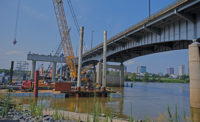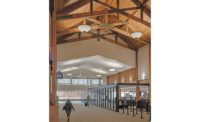Despite pandemic-prompted shutdowns and project pauses in spring 2020, some top design firms in the Southeast saw bright spots mixed in with the gloomy market conditions. Overall, many firms held steady or saw slight dips in revenue, while others improved in 2020 as work picked up throughout the year. Collectively, the 135 engineering and architectural firms included in this year’s survey reported a combined $7.3 billion in revenue, compared with $6.8 billion from the 125 firms in last year’s listings.
“On balance, last year we ended up in a much better place than any of us really expected in terms of being able to weather the storm of ups and downs in the marketplace,” says Tory Winn, principal and managing partner at Gensler, which reported Southeast revenue of $103.9 million in 2020, down from $108.9 million in 2019.
While overall revenue dropped, the multidiscipline firm saw mixed results within its various practice areas. Winn says its lifestyle practice took a hit, particularly hospitality, yet specific areas, such as retail work in the Atlanta market, held up well.
In the office sector, the firm’s workplace practice saw a significant shake-up as clients sought solutions for evolving work environment demands in the coming years. As a result, Winn says the firm’s consulting and workplace strategy practice was busy helping clients find ways to bring employees—both physically and virtually—into a post-pandemic work environment.
“In our 55 years of practice, this has been the most pivotal and transformational moment in our practice,” she says. “We’ve decoupled work and place. The idea of workplace is no longer just office—it’s home or other locations. It has forced us to rethink the way we operate and the employee experience.”
|
Related Link |
Rising Markets
Going forward in 2021, Winn expects interiors and tenant improvement work in the office sector to pick up, especially as landlords improve workspaces to accommodate existing tenants and to attract future ones.
The multifamily residential sector, which has boomed in recent years, showed continued strength in 2020. Jessica Rossi, senior planner and economist at Kimley-Horn, says that initially the pandemic put a pause on residential activity as mobility was hindered and landlords struggled to show properties to prospective tenants. By the end of the second quarter, she says those issues began to ease and activity resumed. On top of that, Rossi says demand is up as many Southeast markets are seeing increased interest in relocations from Northern states.
“There’s real pent-up demand that’s like a big wave coming at us now.”
—Tory Winn, Principal and Managing Partner, Gensler
“There was a blip in leasing pace, but it has fully returned,” she says. In 2020, Kimley-Horn’s multifamily practice garnered $48.96 million in Southeast revenue, up from the $43.2 million it earned in 2019.
As many people stayed home more during the pandemic, Rossi notes that opinions about housing shifted. She says the concept of live-work-play communities became more desirable and more people began to look at properties in suburban settings rather than just the urban core.
“More than half of millennials are over 30 now,” she says. “They are starting families and looking at a different quality of life.”
One emerging trend Kimley-Horn sees in residential is increased demand for access to outdoor spaces, such as trails and parks. “I’ve seen agreements on quite a few projects where private developers offer to complete trail systems because it will serve as an amenity for residents,” she adds.
Lorraine Green, president and chief operating officer at Pond, says parks and trail projects were “put on hold immediately” at the start of lockdowns while larger infrastructure projects continued. Now, with demand increasing for outdoor options, Pond is seeing a rapid return of that work.
“Whenever you build soft infrastructure, like a park or trail, you’re never sure how much a part of the fabric of the community it will become,” she says. “One positive from the pandemic is that local governments can point to the success of their investments in this infrastructure. People have awakened to the need for these facilities.”
Like many firms, Pond saw a drop in retail and commercial office work while multifamily residential remained strong. Light industrial work has also continued a positive trend, including medical supply and warehouse work.
Green says its energy sector work has been “up and down” with some positive growth in renewables and microgrid projects.
Overall, Pond closed out 2020 with $127.7 million in regional revenue, up from $126.8 million the previous year. However, Green notes that because expenses were down due to employees working at home and not traveling as much, profitability was up.
“Revenue-wise, we held steady, but profitability-wise, it was one of our best years,” she added.
The remote-work trend spurred opportunities for WGI. David Wantman, the firm’s CEO, says residential and technology demands helped drive work in 2020.
“The national homebuilders are riding a tremendous demand wave, and this market remains solid,” he says. “Likewise, the work-from-home rotation placed an increased burden on technology infrastructure when millions of workers required remote work conditions. As a result, the already strong data center market just got hotter.”
In the institutional sectors, TLC Engineering Solutions saw expanded opportunities in Florida, where several counties approved sales tax hikes to fund new schools and renovations, says Cheryl Maze, principal at TLC.
The firm also hit its 2020 revenue projections in the health care sector, partly in response to COVID-19-related needs. “[What] COVID definitely made clear for health care providers is the need for [more] beds, [especially] those that can be isolated easily,” she says. On the flip side, some non-COVID-related projects were put on hold as attention shifted to more immediate needs.
In 2021, many firms remain cautiously optimistic as already strong sectors continue to improve and other sectors rebound. Winn says Gensler sees hospitality and lifestyle projects moving forward along with improved opportunities in the mixed-use sector.
“There’s a lot of investment happening,” she says. “We’re excited for 2021 and beyond. There’s real pent-up demand that’s like a big wave coming at us now.”







